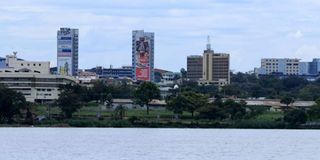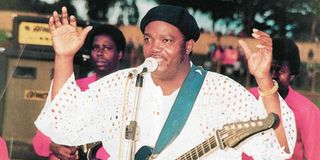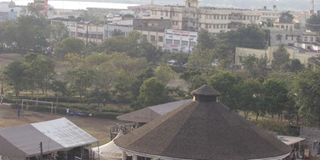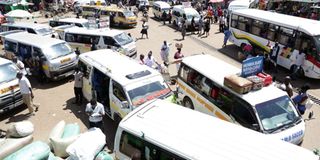Premium
Kisumu's unique history and the origin of its nickname 'Mboka'

Part of Kisumu city's skyline and the port in Lake Victoria in this photo taken on October 20, 2019.
What you need to know:
- Formerly known as Port Florence, Kisumu is the third-largest city in Kenya after Nairobi and Mombasa.
- The name Kisumu was coined from the Luo word “sumo”, which in literal terms means a place of barter trade. To most locals, the city’s name remains Kisumo.
As fans of the legendary Congolese Rhumba maestro Franco Luambo Luanzo Makiadi look forward to celebrating the 31st anniversary of his death next month, Kisumu city will be remembering him for a different reason all together.
While to many the lakeside town is simply known as 'Mboka', very few, though, know the origin of the nickname.
In 1987, when Franco staged a memorable performance at Kisumu’s Moi Stadium, the enthusiastic crowd that stretched from Kisumu Polytechnic to Nyalenda could not contend with the slow pace of gate collectors.

Legendary Congolese Rhumba maestro Luambo Luanzo Makiadi who was popularly known by the stage name Franco.
Hell broke loose the moment Franco, who was also popularly known as Le Grand Maître, twang his guitar and pierced the air with his deep baritone voice.
The impatient crowd ripped down the perimeter fence of the stadium even as the legendary musician beseeched them:
“Bana mboka…calme! Bana mboka…calme!” (people of mboka… calm! People of mboka… calm!).
And with that Kisumu got the nickname, Mboka, which has stuck for decades.
Formerly known as Port Florence, Kisumu is the third-largest city in Kenya after Nairobi and Mombasa, covering approximately 780 square kilometres.
The name was coined from the Luo word “sumo”, which in literal terms means a place of barter trade. To most locals, the city’s name remains Kisumo.
In the earlier days, traders from the Nandi, Kalenjin, Kisii, Luo and Luhya communities converged at the tip of Lake Victoria to exchange different items such as fish, grains, bananas, animal products such as milk, meat, skin and ghee.

Jomo Kenyatta Sports ground in Kisumu with Lake Victoria and the city's CBD in the background.
Asian community
Kisumu also became an important link in the trade route between Lake Victoria and Mombasa because of its water and rail connection that first reached the lakeside city in 1901.
By 1930s and 40s, the city had become a leading East African centre for commerce and administrative centre for the Great Lakes region in western Kenya.
According to former Kisumu Mayor Shakeel Shabbir, who was born and raised in Kisumu, the town was elevated to the status of a Municipal Board in 1940 and later to a Municipal Council in 1960.
At one time, in the 1960s, it is reported that the population of people of Asian descent was higher than the local people.
However, the declaration of Kenya’s independence in 1963 saw an influx of locals into the town, a situation which caused an acute shortage of residential houses, shops and offices.
Mr Shabbir, who is serving his third term as Kisumu East MP, says that while growing up in the neighbourhood of Nyalenda slums, their family associated closely with African families at a time when it was almost considered taboo by the Asian community.
“I used to play with children at Pandpieri in Nyalenda informal settlement. At some point, some members of the Asian community shunned my family for going against the norm,” he said.
He attributes his popularity among the electorate to his good relations with the Luo which, he notes, has helped him to secure his seat for three consecutive terms.
Fond memories
Mr Shabbir’s foray into politics started in the late 1990s when he was nominated to the defunct Kisumu Municipal Council where he rose to be Mayor, first between 2000 and 2002, and later between 2004 and 2006.
Through his influence when he served as the Mayor, Mr Shabbir says he, and other players, pushed for the elevation of Kisumu to a city status during its centenary celebrations in 2001.
The second Kisumu woman Mayor Prisca Auma Misachi, whose family settled in Kisumu in 1968, also has fond memories of the lakeside city.

The bustling Kisumu bus park in this picture taken on December 20, 2019.
“This has been my permanent residence despite having worked in Nairobi for some short stint,” said the 69-year-old who is currently the Kaloleni/Shauri Moyo Member of County Assembly.
Fondly know as 'Mugabe' for her longevity in politics, Mrs Misachi was first elected as a councillor for the then Stadium Ward in 1983. Since then, she only been out of an elective position between 1997 and 2002.
Before the collapse of the railway network and the recurring water hyacinth problem conspired to sink the port’s fortunes, Kisumu pier was stimulated by international business and trade, as well as the shipments of goods destined for Uganda, Tanzania, Burundi, Rwanda and the Democratic Republic of Congo.
Opposition zone
Mrs Misachi has, however, said the advent of devolution is changing Kisumu for the better.
“Kisumu was for many years perceived to be an opposition zone and we did not have much in terms of development before devolution. The ward-based projects being implemented by the county government have a lot of potential going into the future,” she said.
Kisumu City’s main suburbs are Milimani, Riat and Kajulu, which are dominated by high-end residential developments while Manyatta, Lolwe, Poly View and Airport are mid-end residential settlements.
Nyamasaria, Nyalenda, Obunga and Kibos areas are the low-end residential settlements.
Tourist attraction sites
In recent years, several malls, mixed-use developments and hotels have been opened in Kisumu's city center.
Some of the popular malls include West-End, Lake Basin, Mega Plaza, Tuff Foam and Swan Centre while Acacia Premier, Grand Royal Swiss, Imperial Annex and Ciala Resort are some of the luxurious hotels in the lakeside city.
On the outskirts of the city, Hippo Point, Dunga Beach, Kit Mikayi. Ndere Islands National Park and the Kisumu Museum are some of the popular tourist attraction sites. The latter is now well known throughout the world for its fine collections of native Luo culture and the local wildlife.
While Kisumu has modernised over the years, it still maintains that old town feel in some of colonial-era buildings located along Jomo Kenyatta Highway, Oginga Odinga Road, Ang’awa Street and Obote Road as the town clock on the main Oginga Odinga Road remains standing in the middle of the road.





